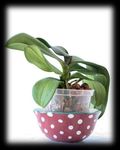Planting and Nurturing - The Landings Garden Club
←
→
Page content transcription
If your browser does not render page correctly, please read the page content below
MISSSION: BEAUTIFICATION … CONSERVATION … EDUCATION
Planting and Nurturing
June 2021
Volume: IV Number: 20
Gardening Issue: Linda Doiron, Editor
Environmental Edition: May, August, November, February - Mary Lovings, Editor
Gardening Edition: June, September, December, March – Linda Doiron, Editor
Landscape Design: July, October, January, April - Suzanne Finger, Editor
All You Have to Do Is Keep It Watered
My college friend gave me an African violet as a gift, and said, “all you have to do is
keep it watered.” Before long I had acquired a special pot, the “right” wick, plant food,
grow light, instructions for care (before the internet) and a love for African violets that
would “grow” into a collection of twenty different types of them within the first year.
Okay, I had an African violet problem when at first all I had to do was just keep one
watered. Ever since then I go through a “check, check, check” to make sure that my
houseplant collection does not exceed my capacity for loving them all. Until now.
I recently discovered semi-hydroponics, and guess what, the addiction to houseplants is
back and all I have to do is “keep them watered.” What is this semi-hydroponics trend?
Semi-hydroponics is a method for growing indoor plants using a medium that is not
bark, peat moss or soil. The difference between hydroponics and semi-hydroponics is
that semi-hydroponics uses wicking action to take up nutrients and water held in a
reservoir.
What medium is it and why does it work? It is an interesting methodology for those
looking for a new challenge to grow plants. Living in Georgia should have given me all
the knowledge I ever needed about clay, but this type of clay medium was news to me.
It is called lightweight expanded clay aggregate, LECA for short. Clay is heated to an
extremely high temperature where it forms air pockets. It is a strong yet lightweight
porous puffed clay rounded stone that creates wicking action through a balance of air
and water. LECA promotes the development of healthy roots by preventing over or
under-watering of houseplants.1 LECA The first step for your semi-hydroponics challenge is to rinse and soak the LECA overnight so that you remove the dust and leech out the minerals. Fill your container about one-third of the way with LECA, then add the plant on top. (If taking a plant out of the soil, first remove as much soil as possible.) Add, shake and distribute more LECA covering the roots. Add water with nutrients to just below the roots. LECA is an inorganic medium so you will need to add nutrients such as a root growth stimulant, Superthrive or other appropriate fertilizer. The roots should not be sitting in water because the idea is that the LECA will provide the wicking action that is the magic of semi-hydroponics. When I first tried semi-hydroponics, I made a mistake, and pass it on so that you will not make the same. I purchased clay pebbles instead of LECA. I thought the pebbles were a better size and aesthetic for my small glass vases, but soon found out that the air and water did not mix properly. Here is a picture of both, and happily, the new cuttings are all thriving now in LECA. (I am saving my clay pebbles for another day.)
2 Left-LECA; Right-clay pebbles
As for containers, I like to use clear glass containers because you can watch root
development, however, glass containers may make your plant susceptible to bacteria
and fungus if the water is not changed on a regular basis. A benefit of using LECA is the
ease of use because you water less often, but with respect to glass, you will need to
change or flush the water more often.
Another type of container to use has both an inner and outer pot for each plant known
as a net pot (inner) and cachepot (outer). Although you can purchase these pots, they
are also quite easy to assemble yourself. There are no holes in the cachepot, and holes
around the inner net pot can be made about one-third of the way up.
3 Net pot (inner): cache pot (my water bottle, hahaha)What are other growing tips beyond potting methods?
➢ Use of inorganic medium- As discussed LECA is an inorganic material and will
not provide enough nutrition for your plants. You will need to add nutrients or
consider a mixture of materials that include inorganic and organic matter.
➢ Water- Make sure you water regularly by changing the water and using distilled
water. The flushing action will improve your plant’s environment by creating air
circulation to the deep zone of the roots.
➢ Spread of fungus and bacteria- Do not reuse water, pots or LECA without
cleaning first, otherwise, you could spread bacteria and fungus to new plants.
➢ Temperatures- Understand the proper temperature for your plants and keep track
of how quickly the water evaporates.
➢ Humidity- LECA may dehydrate your plant at the top of the medium because of
larger pieces while the bottom layer stays very wet. Many have found that the
wicking action of LECA works best in humid conditions where there is a better
chance that wicking will work the entire way through the medium. Some have
added sphagnum moss or stones to improve conditions at the top. A hygrometer
with thermometer can be used to measure both humidity and temperature and
can be purchased for around $10.
➢ Water pH- Balance your water’s pH level by using a nutrient solution called pH-
Up or pH-Down. In general, the best pH range is slightly acidic 5.5-6.5, but you
should find out the correct range for your plant.
➢ Nutrients-Superthrive can help the transition of the plant and reduce shock. Flora
Grow, K-lite and Foliage Pro are popular choices for maintenance and growth.
These are NPK fertilizers providing the nutrients for a strong root system and leaf
growth.
➢ Light- Provide about 12 hours of light per day and adjust as necessary for your
plant.
➢ Results-Happiness abounds with firm leaves, leaf growth, plenty of roots and
blooms.
A list of plants for your semi-hydroponics project follows:
• African Violet
• Alocasia
• Anthurium
• Cast Iron Plant
• Croton
• Dieffenbachia
• Dracaena
• Euphorbia
• Ivy• Hoya • Monstera • Orchid • Peace Lily • Peperomia • Philodendron • Pothos • Schefflera (Above are some ideas from Pinterest. The left picture shows the net pot/ cachepot with an orchid in LECA. The middle picture is a leaf propagation in LECA, and on the right is a picture of a plant in a glass dome that is not only beautiful, but a great way to increase humidity.)
You can also read



























































